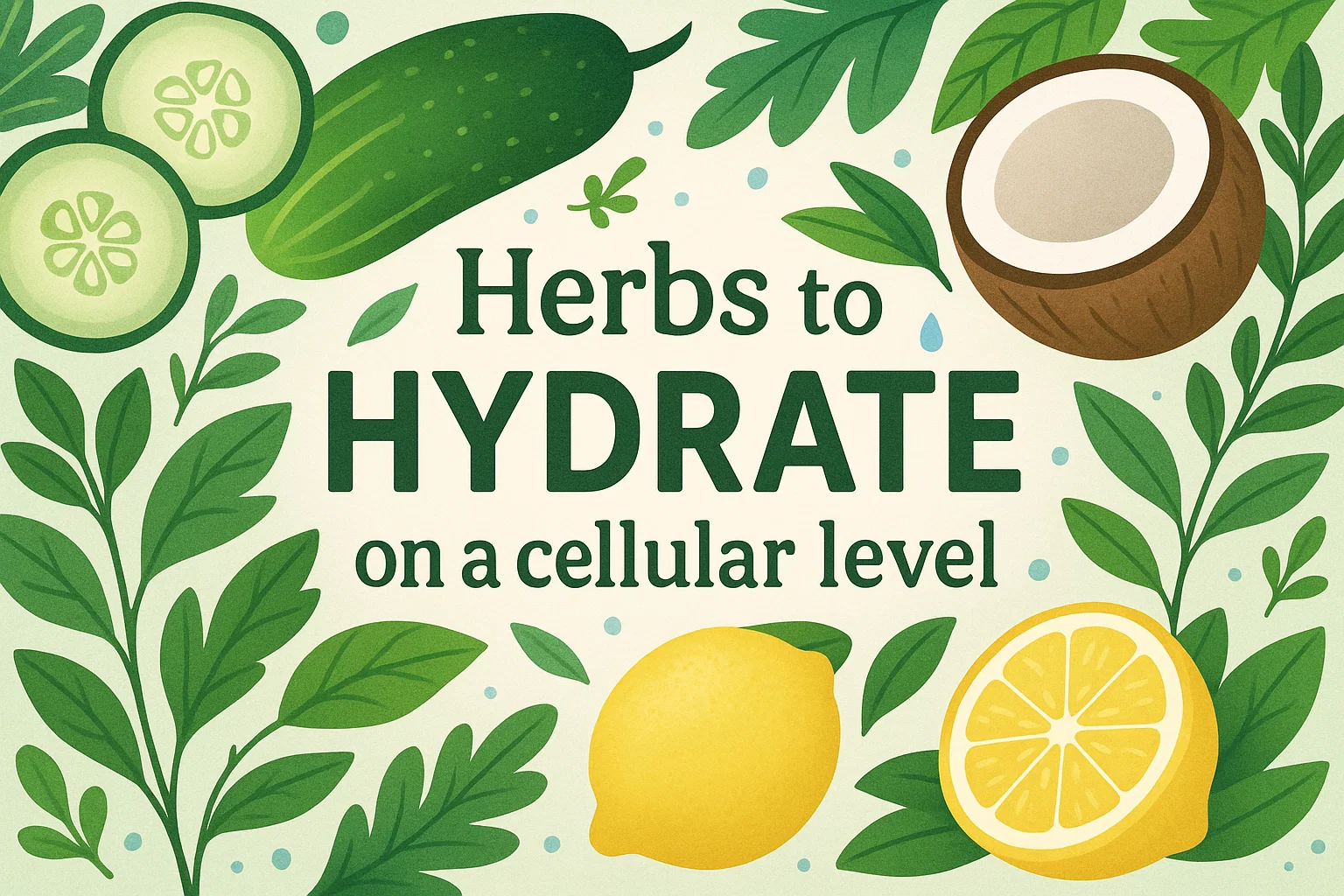Healthy Eating Top Herbs to Hydrate on a Cellular Level for Optimal Wellness
Alright, let’s get real for a second. You chug your eight glasses of water a day, you’ve got that fancy reusable bottle that probably cost more than your weekly coffee budget, and yet… you still feel a bit blah. A little sluggish. Maybe your skin is throwing a tantrum, or your energy levels are doing that weird afternoon nosedive.
I’ve been there. You’re doing everything “right,” but you’re missing a key piece of the puzzle: cellular hydration.
See, it’s not just about how much water you pour down your throat. It’s about whether your cells are actually grabbing that water, doing a little happy dance, and putting it to work. It’s the difference between watering a plant by flooding the top of the soil versus giving it a deep, nourishing soak that reaches every single root. One keeps it alive; the other lets it truly thrive.
So, how do we become that thriving plant? We enlist some powerful, leafy allies from nature’s pharmacy. We’re talking about herbs. Not just any herbs, but specific ones that act like tiny, hyper-efficient hydration conductors, guiding water and nutrients directly to where they’re needed most. Let’s ditch the dehydration and get our cells plump and happy.
Why Your Cells Might Be Thirsty (Even When You’re Not)
Before we get to the good stuff, let’s have a quick science moment—don’t worry, I’ll keep it painless. Think of your cells like tiny water balloons. For them to function optimally—creating energy, repairing themselves, communicating with each other—they need to be nice and full. When they’re not, everything just gets… harder. Your body has to work overtime.
Drinking plain water is fantastic, but sometimes it just passes right through us. Ever notice that sometimes you drink a ton of water and just… pee it all out immediately? Yeah, me too. That’s because proper hydration isn’t just about H2O; it’s about electrolytes—minerals like sodium, potassium, and magnesium—that act like doormen, holding the door open for water to enter our cells.
This is where our herbal heroes come in. Many of them are naturally rich in these essential minerals and compounds that help your body hold onto and utilize water more effectively. They don’t just add water; they help you use it.
The A-List: Your Go-To Herbs for Deep Down Hydration
These aren’t just random plants I pulled from a gardening book. These are the rockstars, the MVPs, the herbs that have been used for centuries to support wellness from the inside out. I’ve personally incorporated most of these into my routine, and the difference in how I feel is honestly not subtle.
Holy Basil: The Stress-Busting Hydrator
Holy Basil, or Tulsi, isn’t just your average pesto ingredient. This herb is sacred in Ayurvedic medicine for a reason—it’s an adaptogen. Fancy word, simple concept: it helps your body adapt to stress.
So what does stress have to do with hydration? Everything. When you’re stressed, your body releases cortisol, a hormone that can seriously mess with your fluid balance and electrolyte levels. It’s like your body goes into crisis mode and forgets how to manage its water supply properly.
Holy Basil steps in like a calm, zen manager. It helps regulate that stress response, which in turn helps your body maintain a better balance of fluids and minerals. You’re not just hydrating; you’re hydrating in a state of calm. I love sipping on a warm cup of Tulsi tea in the afternoon instead of reaching for another coffee. It’s subtly sweet, incredibly soothing, and keeps me from becoming a dehydrated, stress-ball mess.
Nettle Leaf: The Nutrient Powerhouse
I know, I know. The word “nettle” might bring back childhood memories of accidentally brushing against the stinging version and wanting to cry. But trust me, when it’s dried and brewed into a tea, it’s an absolute game-changer. This is, IMO, the ultimate hydration herb.
Nettle leaf is like a multivitamin disguised as a plant. It’s jam-packed with electrolytes—magnesium, potassium, calcium—all the minerals your cells are begging for. It’s not just giving you water; it’s giving you the delivery system too.
But wait, there’s more! It’s also a gentle diuretic. “Hold up,” you might be thinking, “a diuretic makes you lose water, right?” Well, yes and no. Unlike caffeine, which can dehydrate you, nettle helps your kidneys flush out excess fluids and toxins without stripping away those essential electrolytes. It’s a win-win. You’re clearing out the junk while supercharging your cells with hydration and minerals. My skin always looks amazing after a few days of consistent nettle tea.
Alfalfa: The Deep-Rooted Mineral Miner
Alfalfa might be something you associate more with a farmer feeding livestock than with your wellness tea, but hear me out. This herb has roots that dig deep, deep into the soil, which allows it to absorb a massive spectrum of vitamins and minerals that other plants can’t reach.
The result? A leaf that is incredibly dense in nutrients, including chlorophyll (think liquid sunshine for your cells), and—you guessed it—electrolytes. Alfalfa helps to alkalize the body and support the kidneys, which are your master hydration regulators. When your kidneys are happy, your entire hydration system runs more smoothly.
You can find it in tea blends, or as a powder you can add to your morning smoothie. It has a mild, grassy, almost nutty flavor that blends right in. It’s a simple, no-fuss way to give your hydration a major mineral boost.
Dandelion Leaf: The Underestimated Garden Hero
We spend so much time and money trying to kill these things in our lawns, when we should be harvesting them for our health! While dandelion root is famous for liver support, it’s the leaf that’s a hydration superstar.
Much like nettle, dandelion leaf is a potassium-rich diuretic. This is crucial because many modern diets are high in sodium, which disrupts our fluid balance. The potassium in dandelion leaf helps counteract that, ensuring your cells can absorb water effectively instead of just holding onto fluid between your cells (hello, bloat!).
So, dandelion leaf encourages your body to release excess water weight, but it replenishes you with potassium to make sure the water you do drink actually hydrates you. It’s nature’s brilliant balancing act. You can sauté the young greens like you would spinach or, more easily, find it as a tea.
Marshmallow Root: The Slippery Soother
No, not the puffy white campfire kind 🙂 This herb comes from the root of the marshmallow plant and it’s something special. It contains a mucilaginous substance—a thick, slippery gel when mixed with water.
Ever wonder why that gel feels so soothing? Because it literally coats and soothes tissues. When you drink marshmallow root tea (you have to cold-steep it to get the full gelly effect!), it coats your digestive tract. This can not only soothe inflammation but also slow down the absorption of water, giving your body more time to absorb it and pull it into your cells.
It’s like a slow-drip irrigation system for your insides instead of a firehose. This makes it incredibly efficient. If you struggle with a sensitive stomach on top of dehydration, marshmallow root could be your new best friend.
How to Actually Use These Herbs (Without It Being a Chore)
Okay, so you’re sold on the idea. But how do you make this a part of your life without it feeling like a part-time job?
- Tea is Your Easiest Bet: The simplest way to get these herbs into your routine is by drinking them. You can find most of them as single-ingredient teas or in clever hydration-focused blends. Sip them hot or brew a big pot, let it cool, and keep it in your fridge for iced herbal tea all day.
- Smoothie Boosts: Powdered forms of herbs like alfalfa or nettle are perfect for tossing into a green smoothie. You’ll never even taste them behind the banana and spinach.
- Fresh is Fantastic: If you’re a gardener or have access to a good farmer’ market, try incorporating fresh dandelion greens into a salad or sautéing them with garlic.
- Tinctures and Capsules: For a super-concentrated and convenient option, look for high-quality tinctures (liquid extracts) or capsules. This is a great “on-the-go” method.
FYI, always source your herbs from reputable companies to ensure purity and potency. And if you’re on medication or have a health condition, it’s never a bad idea to chat with your doctor before diving into any new herbal regimen. 🙂
Hydration is More Than Just a Checklist
At the end of the day, remember that hydration is a holistic thing. These herbs are powerful tools, but they work best when you’re also eating water-rich foods (hello, cucumbers and watermelon!), managing your stress, and listening to your body.
It’s not about perfection. It’s about making better choices, more often. So, maybe today you swap one coffee for a cup of nettle tea. Maybe next week you add some alfalfa powder to your morning routine. It’s these small, consistent shifts that add up to feeling genuinely well—from the inside out, cell by cell.
Your body is already working incredibly hard to keep you going. Giving it the right tools to hydrate deeply is one of the simplest and most effective ways to say thanks. Now, if you’ll excuse me, my mug of holy basil tea is calling my name.







